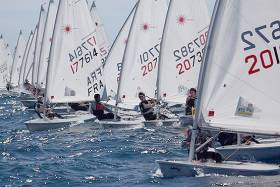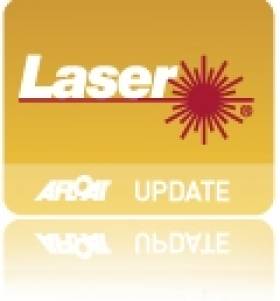Displaying items by tag: Europa Cup
Ninth overall for Johnny Durcan of Royal Cork Yacht Club and Baltimore Sailing Club topped the Irish Laser youth sailors at the massive Laser Europa Cup's 261-boat regatta that concluded in Hyeres on the French Gold coast this afternoon.
In a strong few days for Irish youth sailing, Northern Ireland's Liam Glynn and Ewan McMahon Howth Yacht Club were in a four way tie for the lead and yesterday four Irish were in the top 20 of the Radial division with Glynn setting the pace with three race wins to his credit.
The last two races today however did not all go Ireland's way. Sailing in very light winds, McMahon dropped out of the top ten in the closing stages to be 14th overall.
Seven Irish sailors made the 66–boat gold fleet cut tho, with the National Yacht Club's Loghlen Rickard next in 21st in his first radial event with former Topper World champion Glynn of Ballyholme Yacht Club one place behind. Rickard also came home with a silver medal, placing second in the Under–17 category.
Conor O'Beirne, the Royal St. George's top Radial performer at the recent Irish youth national championships, was next in 27th. Nicole Hemeryck was 51st and Conor Quinn 55th.
Full results here
#laser – The complete absence of any Irish Laser Radial presence at Weymouth for the RYA youth nationals this week is explained by the eight Irish sailors competing at the Laser Europa Cup in Marseille, France. Royal Cork's Seafra Guilfoyle produced a significant 15th overall and top Irish result in the 158–boat fleet. A total of 346 sailors with ages ranging from 15 to 79 competed in this edition of the 2014 series.
Other Irish results were 21 Cian Byrne, 36 Ross O'Sullivan, 48 Dara O'Shea, 66 Ryan Glynn, 71 Liam Glynn, 84 Sarah Eames and 93 Sorcha Ni Shuilleabhan.
French sailor Romain Simonnot (FRA) took the title in the Radial fleet finishing on 21 points followed by another tie between second and third place. Marie Bolou (FRA) and William De Smet (BEL) were tied on 25 points with the French sailor breaking the tie having recorded more third place finishes.
There was a bit of everything wind wise including shifty light to around 15 knots at times.
Racing which concluded today got off most days at around noon except for the third day when the first start was at about five and sailors docking as the sun went down.
First place on the podium for the Standard fleet went to Maxim Nikolaev (RUS) who after 8 races and one discard finished on 17 points.
There was a tie of 19 points for second and third place. Antony Munos (FRA) with two bullets on the final day grabbed second overall and Thorbjorn Schierup (DEN) took third.
The largest fleet of all with a total of 119 competitors was the Laser 4.7. Racing was dominated by Federico Fornasari (ITA) who finished on 10 points from 7 races including one discard. Second place went to Seref Unlu (TUR) on 33 points and Aurelien Pierroz (FRA) with 35 points wrapped up the podium.
Results here.

























































